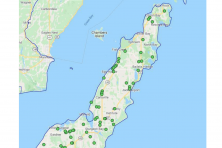Vehicle-Deer Collision Damage Tops $3 Million on Peninsula
- Share
- Tweet
- Pin
- Share
Motorists reported nearly 1,000 collisions with whitetails on the roadways in Door and Kewaunee counties last year. At an average somewhere north of $3,300 per accident, that’s collectively more than $3 million in damages.
Barstool biologists and internet keyboard cowboys have long claimed that the insurance industry pays off the DNR to get hunters to shoot more deer. A nice conspiracy theory, but not true. Pardon the pun, but drivers in deer country simply shell out more “doe” – in the form of higher premiums – to insulate insurance companies from losses.
One can only imagine just how dangerous a night drive could be if deer hunters hadn’t trimmed more than 8,000 whitetails from the Kewaunee County/Door County peninsula last year.
Although fewer vehicle-deer accidents are a bonus of deer hunting, the blaze orange and camo crew also plays a vital role in reducing the crop damage experienced by farmers, orchard owners, gardeners and tree growers.
At the state Natural Resources Board meeting last week, the DNR provided an update on the Agriculture Damage Program with figures from 2017 – the latest data available.
Statewide, more than $1 million in wildlife damage was reported in 70 counties. Deer were identified as the culprits in 81 percent of the damage; black bear and Canada geese 9 percent each, and turkey and elk about 1 percent. Corn and soybeans were the crops most affected.
Even though there is a lot of deer damage to crops in Door County, farmers and orchard owners here typically don’t make claims because of rules that would then force them to allow open hunting. Many – especially passionate hunting families – choose to live with the damage. Others take DNR shooting permits that they can use or give to trusted hunters.
Kewaunee County saw four crop-damage claims totaling more than $18,000 in 2017. That was the most since five claims in 2013 racked up nearly $22,000.
Statewide, more than 500 deer-shooting permits were issued, and 2,946 deer were killed using the special tags.
Fifteen shooting permits were issued for bear, with 55 killed; and 21 shooting permits were provided for turkeys. Forty-nine birds were shot, about half of them damaging ginseng in Marathon County.
Nine permanent fences protecting about 642 acres of high-value crops (orchards, berries, grapes, pumpkins, Christmas trees) were erected, and 218 bears were trapped and relocated because they’d been damaging crops and bee hives or threatening livestock.
Natural Resources Board members also heard highlights from the 2018 bow, crossbow and gun deer-hunting seasons. More than 334,000 whitetails were registered statewide, a 4.4-percent increase from 2017.
Of those, hunters in 49 counties (including Door and Kewaunee) donated 1,505 deer, a slight increase from 2017. At roughly 40 pounds of ground venison per whitetail, that’s about a quarter-million quarter-pound burgers available to local food pantries.
More than 50 deer were donated in Door County, totaling more than 2,000 pounds; 21 whitetails were donated in Kewaunee County.
Whitefish study
DNR fisheries biologist Scott Hansen said preliminary data from a whitefish-movement study in Green Bay and northwest Lake Michigan show that some stocks move around quite a bit, but others seem to stay closer to their late-fall spawning sites.
Of thousands of fish tagged in bay tributaries during the last eight years, only two have been recovered outside of Green Bay.
Hansen said this is a large-scale, cooperative tagging effort with commercial fishermen in Wisconsin and Michigan.
All of last fall’s tag recoveries from the Fox and Menominee rivers were fish that had been tagged there the previous year, which is consistent with known homing tendencies from tagging in the rivers in 2010, 2015 and 2016.
One fish tagged Nov. 30 in Door County’s North Bay was recovered off Two Rivers just four days later.
Short shots
• An Oklahoma woman who bragged about poaching a deer on a dating app had no idea the man she was chatting with was a game warden. He got enough information out of her that she and an accomplice ended up paying $2,400 in fines.
Someone commented on Facebook, “I’m pretty sure a court date wasn’t the type of date she was looking for.”
• The Pope and Young Club has measured a new world-record nontypical mule deer shot in October in Saskatchewan. The buck had a 5×5 frame with 15 abnormal points on each side. It netted 291 1/8 points.
As reported earlier, a pending world-record nontypical whitetail was taken Nov. 2 in Illinois. The buck had 38 scorable points and a net of 320 5/8.




